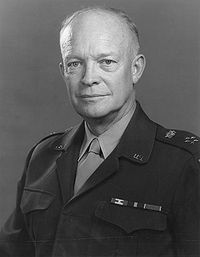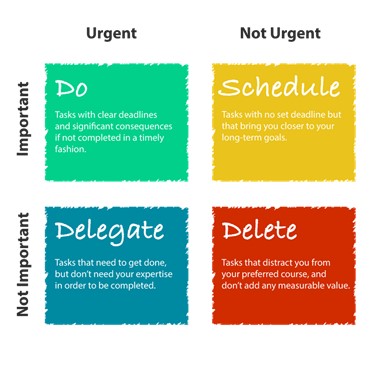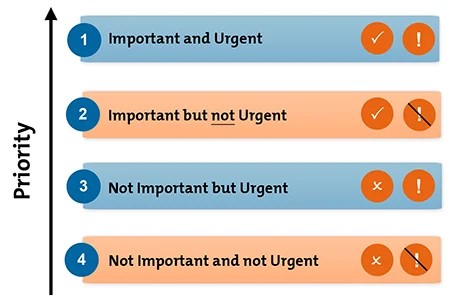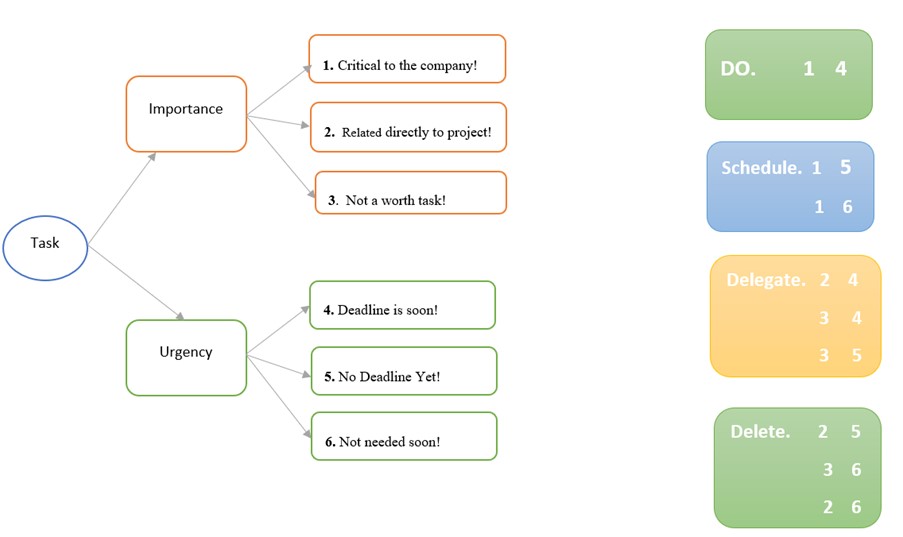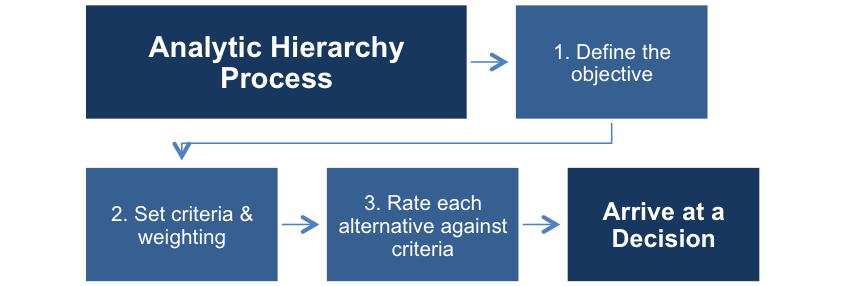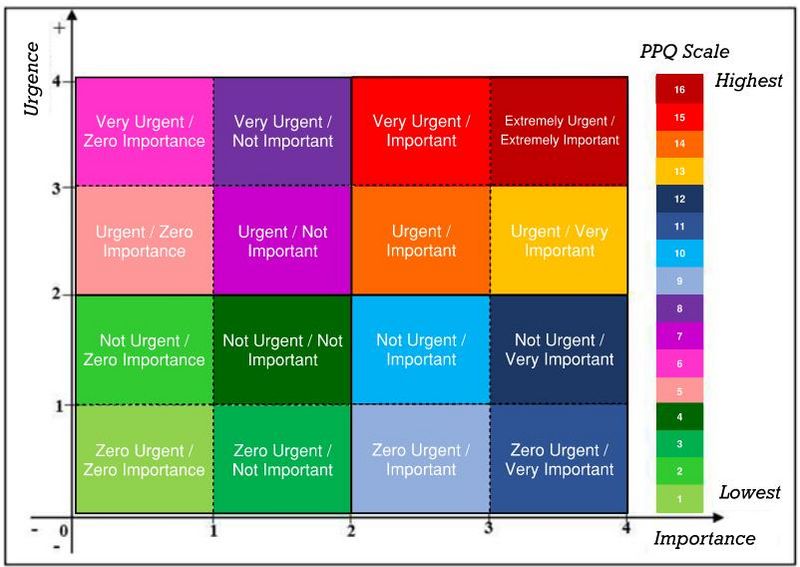Eisenhower decision matrix in project management
| (10 intermediate revisions by one user not shown) | |||
| Line 3: | Line 3: | ||
== Abstract == | == Abstract == | ||
| + | |||
In project management there are numerous roles that are attaining the success of a project by balancing the competing constraints on a project with the resources available. | In project management there are numerous roles that are attaining the success of a project by balancing the competing constraints on a project with the resources available. | ||
| + | |||
The Eisenhower matrix is a frequently used model for project & time management that increases productivity. It is a framework that helps you prioritize a list of activities or assignments by classifying them according to their urgency and significance. It categorizes tasks into four boxes, indicating which should be prioritized, delegated, or deleted. | The Eisenhower matrix is a frequently used model for project & time management that increases productivity. It is a framework that helps you prioritize a list of activities or assignments by classifying them according to their urgency and significance. It categorizes tasks into four boxes, indicating which should be prioritized, delegated, or deleted. | ||
| − | + | The priority on decision-making for different categories of assignments can make the difference between project success and failure and maintaining a balance that can help determine the overall quality of a project. | |
The Eisenhower matrix is a model that can emphasize change in a project. These changes occur because of the environment that projects operate within. Therefore, projects need a good approach to allocate time to activities that are important in addition to those that are urgent. This distinction must be understood to avoid the stress of having too many tight deadlines. | The Eisenhower matrix is a model that can emphasize change in a project. These changes occur because of the environment that projects operate within. Therefore, projects need a good approach to allocate time to activities that are important in addition to those that are urgent. This distinction must be understood to avoid the stress of having too many tight deadlines. | ||
The theory helps project managers to better understand the trade-off dynamics among the four quadrants in the Eisenhower matrix, which simplifies the decision-making process of project management. Even though the Eisenhower matrix is a decent indicator regarding project management success, it is not necessarily the only marker of overall project success. | The theory helps project managers to better understand the trade-off dynamics among the four quadrants in the Eisenhower matrix, which simplifies the decision-making process of project management. Even though the Eisenhower matrix is a decent indicator regarding project management success, it is not necessarily the only marker of overall project success. | ||
| − | The project scope can be delivered on time and within budget but ultimately result in an unsuccessful project, since there are several other aspects that contribute to a project´s efficacy. This article will describe the essence of the Eisenhower matrix, how project managers can apply the concept in practice | + | The project scope can be delivered on time and within budget but ultimately result in an unsuccessful project, since there are several other aspects that contribute to a project´s efficacy. This article will describe the essence of the Eisenhower matrix, how project managers can apply the concept in practice, limitations of the theory and methods for optimizing the model. |
| + | |||
== History of the Eisenhower decision matrix == | == History of the Eisenhower decision matrix == | ||
| + | |||
| + | [[File:Dwight D..jpg|thumb|200px|right|Dwight D. Eisenhower]] | ||
| Line 27: | Line 32: | ||
| − | |||
| − | |||
| − | |||
| + | |||
| + | == The four quadrants of the Eisenhower Matrix == | ||
| + | |||
| + | [[File: Billede3.jpg|frame|Figur 1. The Eisenshower Matrix]] | ||
| + | |||
| + | The Eisenhower Matrix contains four quadrants that help prioritizing tasks based on their urgency. By determining if an assignment belongs in one of these quadrants, it becomes easier to prioritize, delegating to another or include it in a timetable. | ||
The first quadrant of the Eisenhower Matrix "Do" consists of the most important tasks. | The first quadrant of the Eisenhower Matrix "Do" consists of the most important tasks. | ||
| Line 39: | Line 47: | ||
For putting tasks in this category, it's necessary to thoroughly analyze the priorities first for the assignments and then decide if they fit in the "Do" quadrant. For instance, if the task needs to be done within a day, or no longer than the next day, it is an urgent task. | For putting tasks in this category, it's necessary to thoroughly analyze the priorities first for the assignments and then decide if they fit in the "Do" quadrant. For instance, if the task needs to be done within a day, or no longer than the next day, it is an urgent task. | ||
| + | |||
The "schedule" Quadrant: These are important tasks but not urgent. They have a considerably greater influence on a long-term ability to meet the firm's objectives. This might entail a wide range of responsibilities ranging from emails, follow-ups, to more personal appointments etc. Generally, these tasks are in line with long-term goals and contribute to growth.<ref>https://www.ntaskmanager.com/blog/eisenhower-matrix/</ref> | The "schedule" Quadrant: These are important tasks but not urgent. They have a considerably greater influence on a long-term ability to meet the firm's objectives. This might entail a wide range of responsibilities ranging from emails, follow-ups, to more personal appointments etc. Generally, these tasks are in line with long-term goals and contribute to growth.<ref>https://www.ntaskmanager.com/blog/eisenhower-matrix/</ref> | ||
| − | Quadrant two "schedule" allows the project manager to focus on opportunities and growth rather than obstacles and problems. When most of the tasks fall in this quadrant, the project manager needs to be proactive and prioritize activities while also contributing to achieving important goals. | + | Quadrant two "schedule" allows the project manager to focus on opportunities and growth, rather than obstacles and problems. When most of the tasks fall in this quadrant, the project manager needs to be proactive and prioritize activities while also contributing to achieving important goals. |
It is essential that the tasks need to be scheduled in a such a manner that they do not fall into the ‘urgent’ category. The project manager must ensure that there is adequate time to execute them while they still fit in this division.<ref>https://www.ntaskmanager.com/blog/eisenhower-matrix/</ref> | It is essential that the tasks need to be scheduled in a such a manner that they do not fall into the ‘urgent’ category. The project manager must ensure that there is adequate time to execute them while they still fit in this division.<ref>https://www.ntaskmanager.com/blog/eisenhower-matrix/</ref> | ||
| − | |||
| − | |||
The "Delegate" Quadrant: These tasks are not as important, but they are nonetheless urgent. The tasks could for instance include scheduling interviews, replying to certain emails, or team meetings or other activities that could be delegated to others. | The "Delegate" Quadrant: These tasks are not as important, but they are nonetheless urgent. The tasks could for instance include scheduling interviews, replying to certain emails, or team meetings or other activities that could be delegated to others. | ||
| Line 52: | Line 59: | ||
| − | The last quadrant of the Eisenhower Matrix is "Delete". These consist of tasks that are essentially a waste of time and do not contribute to the team's productivity. They do not contribute at all towards the goals. Therefore, it's important to identify these activities and eliminate them. Examples of | + | The last quadrant of the Eisenhower Matrix is "Delete". These consist of tasks that are essentially a waste of time and do not contribute to the team's productivity. They do not contribute at all towards the goals. Therefore, it's important to identify these activities and eliminate them. Examples of insignificant tasks that squandering time, could include spending time on unimportant and non-urgent emails.<ref>https://www.ntaskmanager.com/blog/eisenhower-matrix/</ref> |
| − | + | ||
| − | + | ||
| Line 70: | Line 75: | ||
| − | [[File: | + | [[File: Billede2.jpg|none|frame|Figur 2. Urgent/Important Principle]] |
| Line 78: | Line 83: | ||
| − | == Relation to | + | == Relation to Time management == |
| + | |||
| + | Time management becomes a critical component of organizational management in order to achieve high productivity, and therefore we need to understand that time management is essential as a component of the teams’ responsibilities and accountability. | ||
| + | |||
| + | The Eisen matrix is one of many ways to organize time, the fundamental basis for any time management process is linked to the planning process. The Eisenhower matrix will set the priorities, the vision and goal of the organization, furthermore, assist employees in determining their work and what is most important to accomplish. Its provides an outline of steps in the planning process linking time management to cost savings for an organization. | ||
| + | |||
| + | The Eisen shower matrix is the goal setting process to managing time as it is the basis for articulation of priorities, determination of action items. But more importantly, the vision of the organization is the foundation of determining if time is being utilized to advance or manage the organization. In juggling multiple tasks and responsibilities, individuals will have a better sense of what is important if they know the vision and goals of the organization to help them focus on priority projects. The method also plans a way to avoid wasted tasks and underproductive time. <ref>JOURNAL ARTICLE Time Management, Farrell, Maggie - Journal of Library Administration — 2017, Volume 57, Issue 2, pp. 215-222</ref> | ||
| + | |||
| + | The Eisen shower matrix helps leaders to determine where to spend the majority of one's time or how to direct others in their time management challenges. The Eisen shower matric is the main component of the planning process, that ensure the employees to know, the broader goals and priorities and will assist in allocating their time and assessing work responsibilities. | ||
| + | |||
| + | Once the team and the leader have an overview on how time is being used, then adjustments can be made to be more effective in managing time. | ||
| + | The articulated priorities and time audit will assist the leader in determining how time should be allocated in order to be successful for the organization. | ||
| + | |||
| + | The Eisenhower matrix provide delegation, which is important as a time management tool, because it prioritizes the time of individuals while assigning responsibilities to those who are best able to manage a task due to time, level of responsibility, and/or knowledge. A leader learns to determine when a task is better managed by another individual or that individual needs to develop their skills in an area to be more effective or to build skills for career development.<ref>JOURNAL ARTICLE Time Management, Farrell, Maggie - Journal of Library Administration — 2017, Volume 57, Issue 2, pp. 215-222</ref> | ||
| + | |||
| + | Outlining the sphere of responsibility will help everyone in the organization to manage their time and this will contribute to effective decision-making processes. | ||
| + | |||
| + | |||
| + | |||
| + | == Relation to Project management == | ||
| Line 104: | Line 128: | ||
:- Not needed anytime soon. | :- Not needed anytime soon. | ||
| − | The following matrix will demonstrate the concept | + | The following matrix will demonstrate the concept: |
| − | [[File: | + | [[File: Billede1.jpg]] |
| Line 125: | Line 149: | ||
== Optimization of the Eisenhower decision matrix == | == Optimization of the Eisenhower decision matrix == | ||
| − | + | Currently, there is no system or tool to organize the project related tasks and segregate it on priority. Task Matrix” helps teams to define the tasks using “Eisenhower matrix” and share it across easily. This proposed solution helps project management team and fellow team members to organize task effectively. <ref>(A study on task management system | IEEE Conference Publication | IEEE Xplore)</ref> | |
| + | |||
| + | Another prospect for potentially optimizing the Eisenhower matrix is to combine it with the Analytic Hierarchy Process (AHP), which could be a feasible strategy - But, before we go any further, let's inspect the AHP method and what it stands for. | ||
| + | |||
| + | |||
| + | [[File:Ah2.png|frame|50px|none|Figur 3. The Analytic Hierarchy Process]] | ||
| + | |||
| + | |||
| + | The Analytic Hierarchy Process (AHP) is a math and psychology-based system for organizing and evaluating complicated decisions. It was created in the 1970s by Thomas L. Saaty and has been refined since then. | ||
| + | The method is divided into three sections: | ||
| + | |||
| + | :- The ultimate goal or problem the organization are attempting to solve. | ||
| + | :- The all-viable solutions, known as alternatives | ||
| + | :- The criteria the organization can use to evaluate the alternatives. | ||
| + | |||
| + | AHP provides a reasonable framework for a required decision by quantifying its criteria and alternative possibilities, as well as connecting those components to the overall goal. | ||
| + | The AHP is particularly helpful for solving complicated issues with large stakes. It differs from previous decision-making methods as it quantifies criteria and possibilities that are generally difficult to measure with clear numbers. Rather of prescribing a "good" decision, AHP assists decision makers in finding the one that best fits their values and knowledge of the problem.<ref>https://www.passagetechnology.com/what-is-the-analytic-hierarchy-process</ref> | ||
| + | |||
| + | The Eisenhower matrix and Analytical Hierarchy Process is tools to strengthen the prioritization of actions for managers. Making the best decisions becomes an increasingly demanding task for managers of companies in different fields. | ||
| + | The Eisenhower technique focuses on resolving time, and task management challenges that arise as a result of poor prioritization. The Analytic Hierarchy Process assists the decision maker in establishing priorities in the most objective manner and making the best decision. Nevertheless, what most decision-makers want is to carry out their activities in the most efficient manner possible. To overcome this problem, combining the two methods and approaches into a single tool would be beneficial. The tool was invented on a PhD project that explored a new model that integrated the two methods, and as a result, a new tool known as the Accessibility Governance Matrix was created. | ||
| + | |||
| + | |||
| + | [[File: 800px-Eisenhower Decision Matrix extended version.jpg|none|frame|Figur 4. The Accessibility Governance Matrix]] | ||
| + | |||
| − | The | + | The four basic quadrants of the Eisenhower matrix are now sub-matrixes of the AGM, and each is broken into four sub-quadrants, making it easier to pinpoint the level of importance and urgency. |
| − | + | ||
| − | + | The Absolute superlatives are added to basics qualifiers to express the extreme quality and degree of integrated priority to the relevant quadrants. | |
| + | The Precedence of urgency and importance depends on the proximity or distance of the axes on which they are represented. However, the higher extreme quadrant, qualified as "Extremely Important / Extremely Urgent", gave precedence to importance, which assumes quick turnaround planning for areas of deficiencies presented as crises. | ||
| − | + | The axes of urgency and importance are calibrated to identify and numerically frame the sub-quadrants and quadrants, as well as their priority contents.<ref>Eisenhower matrix * Saaty AHP = Strong actions prioritization? Theoretical literature and lessons drawn from empirical evidences by Alfred Homère NGANDAM MFONDOUM1*, Mesmin TCHINDJANG2, Jean Valery MEFIRE MFONDOUM3, Isabelle MAKOUET4</ref> | |
| + | Moreover, this tool with the different parameters inside the megamatrix can set new ways to help an organization manage time and give a plan, to know the priorities, focus on activities that advance the goals of the organization, delegate and outline authority responsibilities. | ||
| − | |||
== References == | == References == | ||
Latest revision as of 15:16, 3 April 2022
Contents |
[edit] Abstract
In project management there are numerous roles that are attaining the success of a project by balancing the competing constraints on a project with the resources available.
The Eisenhower matrix is a frequently used model for project & time management that increases productivity. It is a framework that helps you prioritize a list of activities or assignments by classifying them according to their urgency and significance. It categorizes tasks into four boxes, indicating which should be prioritized, delegated, or deleted. The priority on decision-making for different categories of assignments can make the difference between project success and failure and maintaining a balance that can help determine the overall quality of a project.
The Eisenhower matrix is a model that can emphasize change in a project. These changes occur because of the environment that projects operate within. Therefore, projects need a good approach to allocate time to activities that are important in addition to those that are urgent. This distinction must be understood to avoid the stress of having too many tight deadlines. The theory helps project managers to better understand the trade-off dynamics among the four quadrants in the Eisenhower matrix, which simplifies the decision-making process of project management. Even though the Eisenhower matrix is a decent indicator regarding project management success, it is not necessarily the only marker of overall project success.
The project scope can be delivered on time and within budget but ultimately result in an unsuccessful project, since there are several other aspects that contribute to a project´s efficacy. This article will describe the essence of the Eisenhower matrix, how project managers can apply the concept in practice, limitations of the theory and methods for optimizing the model.
[edit] History of the Eisenhower decision matrix
The Eisenhower Matrix model was designed by Dwight D. Eisenhower, the 34th President of the United States. Eisenhower also served as Supreme Commander of the Allied forces during World War II and subsequently led NATO. He was well-known for his strategic and productive mind.
Eisenhower effectively de-escalated Cold War situations, ending the Korean War and keeping the United States at peace. Eisenhower was a skilled organizer who managed to stay on top of things by differentiating between the important and the urgent. When asked what principle he adheres to when dealing with his multiple obligations, he stated, “What is important is seldom urgent, and what is urgent is seldom important.” This principle was built on this premise, later known as the Eisenhower Matrix.[1]
[edit] The four quadrants of the Eisenhower Matrix
The Eisenhower Matrix contains four quadrants that help prioritizing tasks based on their urgency. By determining if an assignment belongs in one of these quadrants, it becomes easier to prioritize, delegating to another or include it in a timetable.
The first quadrant of the Eisenhower Matrix "Do" consists of the most important tasks. The assignments on this quadrant are critical activities that must be completed as soon as possible. These are the activities that must be completed to avoid adverse effects. Crises, deadlines, and pressing concerns are examples of the "Do" quadrant. These tasks generally take the most time because of the amount of effort they require.
For putting tasks in this category, it's necessary to thoroughly analyze the priorities first for the assignments and then decide if they fit in the "Do" quadrant. For instance, if the task needs to be done within a day, or no longer than the next day, it is an urgent task.
The "schedule" Quadrant: These are important tasks but not urgent. They have a considerably greater influence on a long-term ability to meet the firm's objectives. This might entail a wide range of responsibilities ranging from emails, follow-ups, to more personal appointments etc. Generally, these tasks are in line with long-term goals and contribute to growth.[2]
Quadrant two "schedule" allows the project manager to focus on opportunities and growth, rather than obstacles and problems. When most of the tasks fall in this quadrant, the project manager needs to be proactive and prioritize activities while also contributing to achieving important goals. It is essential that the tasks need to be scheduled in a such a manner that they do not fall into the ‘urgent’ category. The project manager must ensure that there is adequate time to execute them while they still fit in this division.[3]
The "Delegate" Quadrant: These tasks are not as important, but they are nonetheless urgent. The tasks could for instance include scheduling interviews, replying to certain emails, or team meetings or other activities that could be delegated to others. The project manager could conduct those tasks by himself. However, it would be more rational to delegate these tasks to others, which would result in a more effective approach of managing the workload and giving other team members the opportunity to broaden their skill set. This might also lead to increased production and efficiency, as well as more time for the team to complete the activities in the first two quadrants, since completing tasks in the third quadrant does nothing to inch them closer to their long-term goals.[4]
The last quadrant of the Eisenhower Matrix is "Delete". These consist of tasks that are essentially a waste of time and do not contribute to the team's productivity. They do not contribute at all towards the goals. Therefore, it's important to identify these activities and eliminate them. Examples of insignificant tasks that squandering time, could include spending time on unimportant and non-urgent emails.[5]
[edit] The difference between urgent and important tasks
The Eisenhower Matrix was also known as Urgent Important Matrix, because during Dwight D. Eisenhower's career, he frequently had to take many difficult decisions; everything was urgent and important. He wondered what urgency meant exactly and reached the conclusion that if it didn't need to be done today, it wasn't urgent.[6]
By determining if a task or assignment is urgent or important, we need to understand the distinction:
- Important activities are tasks that contribute to projects long-term goals, objectives, and values. They might not produce instant outcomes which makes them easier to overlook, but however, they are occasionally, but not always, urgent.
- Urgent activities are tasks that are time-sensitive, and demand immediate attention, and are usually associated with achieving the clients’ goals, such as handling an urgent request from the client. They demand attention, because there are clear consequences if these tasks aren’t complete within a certain timeline.
Knowing which activities are important and which are urgent, will provide adequate time to determine what is essential to the project's success, while unimportant activities will be assigned or removed. [7]
The figure depict Eisenhower's Urgent/Important Principle, which helps to quickly identify the activities that require attention, as well as those that should be neglected
It is essential to point out that important tasks might become urgent if they are postponed for a long time. It is natural to assume that all urgent tasks are likewise important, which is usually not the case. This misconception may be due to our predisposition for focusing on current problems and solutions.
[edit] Relation to Time management
Time management becomes a critical component of organizational management in order to achieve high productivity, and therefore we need to understand that time management is essential as a component of the teams’ responsibilities and accountability.
The Eisen matrix is one of many ways to organize time, the fundamental basis for any time management process is linked to the planning process. The Eisenhower matrix will set the priorities, the vision and goal of the organization, furthermore, assist employees in determining their work and what is most important to accomplish. Its provides an outline of steps in the planning process linking time management to cost savings for an organization.
The Eisen shower matrix is the goal setting process to managing time as it is the basis for articulation of priorities, determination of action items. But more importantly, the vision of the organization is the foundation of determining if time is being utilized to advance or manage the organization. In juggling multiple tasks and responsibilities, individuals will have a better sense of what is important if they know the vision and goals of the organization to help them focus on priority projects. The method also plans a way to avoid wasted tasks and underproductive time. [8]
The Eisen shower matrix helps leaders to determine where to spend the majority of one's time or how to direct others in their time management challenges. The Eisen shower matric is the main component of the planning process, that ensure the employees to know, the broader goals and priorities and will assist in allocating their time and assessing work responsibilities.
Once the team and the leader have an overview on how time is being used, then adjustments can be made to be more effective in managing time. The articulated priorities and time audit will assist the leader in determining how time should be allocated in order to be successful for the organization.
The Eisenhower matrix provide delegation, which is important as a time management tool, because it prioritizes the time of individuals while assigning responsibilities to those who are best able to manage a task due to time, level of responsibility, and/or knowledge. A leader learns to determine when a task is better managed by another individual or that individual needs to develop their skills in an area to be more effective or to build skills for career development.[9]
Outlining the sphere of responsibility will help everyone in the organization to manage their time and this will contribute to effective decision-making processes.
[edit] Relation to Project management
Portfolio, program, and project management provide a structured way to align and effectively carry out organizational strategies. However, there is a difference in their focus and contribution to the attainment of strategic objectives and the theory regarding the Eisenhower matrix is primarily associated with project management. Project management is the application of knowledge, tools, and techniques to meet the project's requirements. Project management consequently helps organizations to increase chances of success and growth, as well as meet business objectives. On the other hand, poorly managed projects may result in cost overruns, missed deadlines etc. Utilizing the Eisenhower matrix can help project managers with these common challenges. Eisenhower is very critical regarding project management because when one know how to organize, schedule and delegate tasks this will lead to achieving the desired goals of the project. [10] Through that matrix, project managers could specify ways to:
- Determine the importance of the tasks to the project
- The effort needed to achieve the required tasks
- The time required to complete the tasks – meeting the deadlines.
In other words, the Eisenhower Matrix can help managers to do the right thing, at the right time and in the right place. However, the most tricky part of the Eisenhower Matrix for time management is to classify tasks depends on the importance and the urgency. And the best way to avoid such a conflict is to use an algorithmic perspective on the Eisenhower Matrix. This could be started by specify some statements to make it related to importance and urgency such as follows.
The statement of importance:
- - Critical to the company
- - Related directly to projects
- - Not a worthy task
The statements of urgency:
- - Deadline is soon.
- - No deadline has been set for this task
- - Not needed anytime soon.
The following matrix will demonstrate the concept:
As we have demonstrated, the Eisenhower Matrix and Project management are a perfect technique to assist organizations to increase chances of success and growth. However, the Eisenhower may also not be ideal when there are too many tasks to be taken care of a single department. Because it might be time constraint to categorize them and classifying them especially in a changing environment, which will lead us to write more about limitations in the next paragraph.
[edit] Limitation of the Eisenhower decision matrix
We have seen that organizing, scheduling, delegating, and deleting tasks are critical steps to maximizing task productivity by segregating tasks on the basis of importance and urgency of deliverables. However, prioritization based on metrics will result in two main issues:
- - 1. The results of prioritization are rather arbitrary: This is due to the fact that there are some situations where factors are unknown until a decision is made. So the negative outcome of a decision might results in huge costs and resources to the company. There are many research and prototypes that helps in prioritizing. However, the large number of ideas means as well the semi-impossibility to do this with each one. It might appear some frameworks that could assist in solving this problem by incorporating a confidence component. However, these frameworks that make it easier to distinguish high-value low-effort items among others are generally straightforward to recognize, even without the assistance of frameworks.
- - 2. Prioritization frameworks address the wrong problems: The central idea behind the prioritization is the capability and confidence in doing, scheduling, delegating, or deleting tasks. However, prioritization frameworks might address too many problems by delegating and scheduling too many projects. These can be illustrated when telling stakeholders that their tasks are not going to be executed right now could result in teams taking on too many projects or tasks. Taking too many projects will result that the team would not have enough time for execution or for revisions that are needed to ensure the expected business value is delivered.[11]
[edit] Optimization of the Eisenhower decision matrix
Currently, there is no system or tool to organize the project related tasks and segregate it on priority. Task Matrix” helps teams to define the tasks using “Eisenhower matrix” and share it across easily. This proposed solution helps project management team and fellow team members to organize task effectively. [12]
Another prospect for potentially optimizing the Eisenhower matrix is to combine it with the Analytic Hierarchy Process (AHP), which could be a feasible strategy - But, before we go any further, let's inspect the AHP method and what it stands for.
The Analytic Hierarchy Process (AHP) is a math and psychology-based system for organizing and evaluating complicated decisions. It was created in the 1970s by Thomas L. Saaty and has been refined since then.
The method is divided into three sections:
- - The ultimate goal or problem the organization are attempting to solve.
- - The all-viable solutions, known as alternatives
- - The criteria the organization can use to evaluate the alternatives.
AHP provides a reasonable framework for a required decision by quantifying its criteria and alternative possibilities, as well as connecting those components to the overall goal. The AHP is particularly helpful for solving complicated issues with large stakes. It differs from previous decision-making methods as it quantifies criteria and possibilities that are generally difficult to measure with clear numbers. Rather of prescribing a "good" decision, AHP assists decision makers in finding the one that best fits their values and knowledge of the problem.[13]
The Eisenhower matrix and Analytical Hierarchy Process is tools to strengthen the prioritization of actions for managers. Making the best decisions becomes an increasingly demanding task for managers of companies in different fields. The Eisenhower technique focuses on resolving time, and task management challenges that arise as a result of poor prioritization. The Analytic Hierarchy Process assists the decision maker in establishing priorities in the most objective manner and making the best decision. Nevertheless, what most decision-makers want is to carry out their activities in the most efficient manner possible. To overcome this problem, combining the two methods and approaches into a single tool would be beneficial. The tool was invented on a PhD project that explored a new model that integrated the two methods, and as a result, a new tool known as the Accessibility Governance Matrix was created.
The four basic quadrants of the Eisenhower matrix are now sub-matrixes of the AGM, and each is broken into four sub-quadrants, making it easier to pinpoint the level of importance and urgency.
The Absolute superlatives are added to basics qualifiers to express the extreme quality and degree of integrated priority to the relevant quadrants.
The Precedence of urgency and importance depends on the proximity or distance of the axes on which they are represented. However, the higher extreme quadrant, qualified as "Extremely Important / Extremely Urgent", gave precedence to importance, which assumes quick turnaround planning for areas of deficiencies presented as crises.
The axes of urgency and importance are calibrated to identify and numerically frame the sub-quadrants and quadrants, as well as their priority contents.[14]
Moreover, this tool with the different parameters inside the megamatrix can set new ways to help an organization manage time and give a plan, to know the priorities, focus on activities that advance the goals of the organization, delegate and outline authority responsibilities.
[edit] References
[edit] Notes
- ↑ https://hello.ducalis.io/prioritization-frameworks/tst?utm_source=google&utm_medium=cpc&utm_campaign=search-dsa-tofu-ww_15271674469&utm_content=Framework:Eisenhower-Matrix_135463940611&utm_term=&gclid=CjwKCAiA6seQBhAfEiwAvPqu10QVnTUw0v7sqhlogq34mHlgYEMBB6bUtXIkep99oIUx9j37WNWGAxoCk3oQAvD_BwE
- ↑ https://www.ntaskmanager.com/blog/eisenhower-matrix/
- ↑ https://www.ntaskmanager.com/blog/eisenhower-matrix/
- ↑ https://www.ntaskmanager.com/blog/eisenhower-matrix/
- ↑ https://www.ntaskmanager.com/blog/eisenhower-matrix/
- ↑ https://www.toolshero.com/personal-development/eisenhower-matrix/
- ↑ https://slab.com/blog/eisenhower-matrix/
- ↑ JOURNAL ARTICLE Time Management, Farrell, Maggie - Journal of Library Administration — 2017, Volume 57, Issue 2, pp. 215-222
- ↑ JOURNAL ARTICLE Time Management, Farrell, Maggie - Journal of Library Administration — 2017, Volume 57, Issue 2, pp. 215-222
- ↑ Jyothi, N.S. and Parkavi, A., 2016, May. A study on task management system. In 2016 International Conference on Research Advances in Integrated Navigation Systems (RAINS) (pp. 1-6). IEEE.
- ↑ https://hello.ducalis.io/prioritization-frameworks/tst?utm_source=google&utm_medium=cpc&utm_campaign=search-dsa-tofu-ww_15271674469&utm_content=Framework:Eisenhower-Matrix_135463940611&utm_term=&gclid=CjwKCAiA6seQBhAfEiwAvPqu10QVnTUw0v7sqhlogq34mHlgYEMBB6bUtXIkep99oIUx9j37WNWGAxoCk3oQAvD_BwE
- ↑ (A study on task management system | IEEE Conference Publication | IEEE Xplore)
- ↑ https://www.passagetechnology.com/what-is-the-analytic-hierarchy-process
- ↑ Eisenhower matrix * Saaty AHP = Strong actions prioritization? Theoretical literature and lessons drawn from empirical evidences by Alfred Homère NGANDAM MFONDOUM1*, Mesmin TCHINDJANG2, Jean Valery MEFIRE MFONDOUM3, Isabelle MAKOUET4
